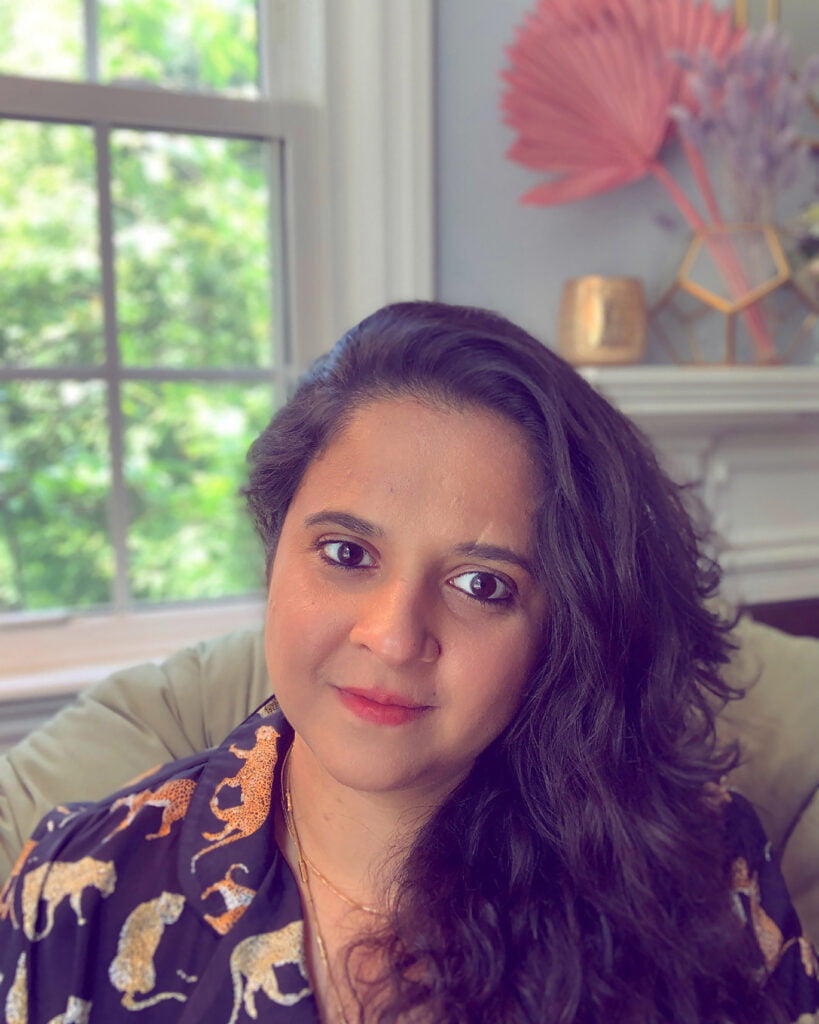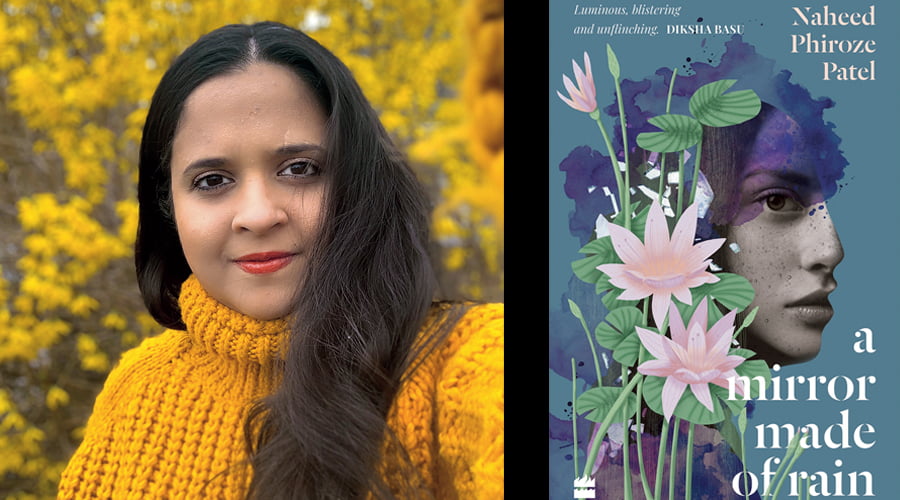“Feelings, it turns out, are harder to get rid of than a turmeric stain on a white kurta,” writes Naheed Phiroze Patel in her brilliant debut novel A Mirror Made of Rain (Fourth Estate, an imprint of HarperCollins Publishers, 2021). A complex narrative, this book sifts through the past and the present meticulously, conveying how patriarchal upbringing and intergenerational trauma are not only hard to erase but demand constant negotiation as domestic violence remains uniquely rationalised.
Naheed’s writing has appeared in The Guardian, Huffington Post, New England Review, BOMB Magazine, The Rumpus, EuropeNow Journal, PEN America, and elsewhere. Her work has been supported by Columbia University School of the Arts where she received her MFA. Her debut novel, A Mirror Made of Rain, was published by HarperCollins India in May 2021.
In this exclusive interview with FII, Naheed tell us how she chiselled her prose to perfection and what went into the creation of this book.

Q: Each character in your book, with their idiosyncrasies, has something to contribute to preserving, lending indirect support, or challenging the structures of patriarchy, misogyny in the prevalent heteronormative Indian society. Please tell us how you conceptualised the universe of A Mirror Made of Rain.
A: For me—the universe of any story becomes fully realised only after many, many drafts, and many early readers. Each round of reads gave a new dimension to a character or a situation for me to mull on. There is nothing better than workshopping a story with folks you trust and whose opinion you respect to make it shine. In my case, I was fortunate to have first readers—including my brilliant editor at HarperCollins Publishers, India—who really understood this project.
Q: Writing about intergenerational trauma, grief, and everyday violence that punctuates the life of a woman in a small town, and even in metro cities like Delhi, as you put it succinctly— “I understood that violence could be transmitted by the most innocuous-seeming acts”— can be traumatic for the writer itself. What part of personal and observed realities informed you while writing this book? And did you, in a colloquial way, felt liberated or overwhelmed after having finished this work?
A: When a book is out in the world, it no longer belongs to the author. You have zero control. For a person like me, who prefers to be in the driver’s seat, this can be a bit traumatic. But it is an excellent (and hard) lesson in the art of detachment. Some of the scenes were definitely traumatising to write—I had to take long breaks in between those scenes for my mental health. Therapy helped. It gave me the language to articulate certain things that had bothered me for years—the everyday violence that women experience—not just from men, but sometimes from other women as well. I realised misogyny is not restricted to any one gender, and neither is feminism. So, in a way, I’m grateful for the extreme polarity of reactions to the novel’s narrator—I feel like it reveals so much more about where that reader stands on the spectrum of misogyny and how much they have been socialised to accept the invisible emotional labour of women as a given. Noomi is a mirror that tells you about yourself.
In terms of observed realities, I did not feel at all comfortable about writing from outside my own experience. I felt especially squeamish or uncomfortable about writing from the point of view of characters who are marginalised by poverty. It felt too much like appropriation. But because Noomi is not financially precarious is not a reason to summarily dismiss her mental health problems. In a way, writing this difficult, messy character has really shown me the limits of some people’s empathy.
Also read: In Conversation With Aqui Thami: The Founder Of Sister Library
Q: What makes the daughter-mother relationships unique is that there never appears a dull moment whenever Noomi and Asha are talking or not talking with each other?
A: You know, I’m sorry to keep returning to this one particular metaphor, but the reason I think it works is that the women really are mirrors of each other. And they reflect each other in the poorest light possible! The conflict inherent in this antagonistic relationship makes for some interesting viewing. Like a boxing match.
Q: In many ways Veer (Noomi’s husband) and Jeh (Noomi’s father), as Noomi also notes, are alike. Do you think that both, though adorable men, lacked a spine to support their wives when they needed or expected them?
A: I said this during a live interview, but I think it bears repeating. Toxic masculinity harms men as much as it does women. Jeh and Veer are perfect examples of men who know what the right thing to do is, but they are held back by something—perhaps a notion of how a man is supposed to behave in their situation. Perhaps if they didn’t have such overbearing patriarchs as fathers, they would’ve had the courage to step up and support the women in their lives in a more meaningful way.
Q: I personally believe marriage is an institution of violence. It perpetuates all so-called “evils” of society that get constructed the moment a cisgender man and a woman are announced “man and wife”. Would you agree that most intergenerational trauma and familial violence can be averted by doing away with heteronormative marriages?
A: It’s definitely an interesting theory. But theories need to be proved, you know? How would one go about doing that on a large scale? I feel that as long as problems like internalised misogyny and socially acceptable gender-based violence are prevalent, it doesn’t really matter whether it is occurring inside or outside the structure of cis-het marriage. Non-normative relationships can and do turn violent as well—but because they are not currently within the ambit of the law (at least in many countries), there is even less recourse or remedy available to the victims in those cases. A possible more doable solution might be to have more types of relationships recognised and the rights, safety of the people involved guaranteed—to eliminate or mitigate intergenerational harm. That plus a substantial re-education on gender roles. Because if you are bringing the same screwed-up dynamics to any relationship outside the hegemonic norm then we are right back where we started.
Q: When Veer wants Noomi to “bond” with her mother and women of the house, Noomi retorts: “Why can’t we bond like normal people – over shared traumas and suchlike?” Why do you think such bonding exercises, which are core in the case of most friendships, missing in a marriage setup?
A: I read online somewhere how we are taught by society and the media to put all our eggs in the basket of a “soul-mate”—at the detriment of all the other meaningful, supportive relationships that we have the capacity, over our lifetimes, to develop and nurture. I think about that a lot. A person can waste their whole life in search of a perfect romantic partner, meanwhile ignoring or even destroying platonic relationships that can be more rewarding than romantic love.
Q: At what point do you think the line between self-inflicting harm and muted violence gets blurred when it comes to people who one loves? Most people are rude to those whom they love. How does one then separate love and hatred in a relationship?
A: I think harm occurs when we start to see other people, especially immediate family members, as extensions of ourselves and our egos. This gives us permission to act in all sorts of toxic ways—and call it “love”. In my lived reality, I’ve seen that occurring a lot. We superimpose our own desires and dreams on our children or our partners and say it is a form of caring, but it is only control. And then we are enraged when they reject this particular form of “love”.
Q: I was overjoyed when Noomi observes that when Bade Papa and Mr. Malhotra are served rotis, they don’t say ‘thank you’. I am reminded of a story where it’s mentioned how different stories are when told by women. Naipaul, the sexist Nobel Laureate, however, had supernatural powers to “point out what’s written by women”. In the light of these two observations, would you explain why women’s writing is enriching?
A: Instead of explaining how women’s writing is enriching (it’s pretty self-evident, no? Just pick up any book by astonishing, brilliant writers like Janice Pariat, Avni Doshi, Sheila Heti, Amanda Lee Koe, Brit Bennett, Solmaz Sharif), let’s talk about how impoverished we become when women’s voices and writing are erased or invisiblised. I’m thinking of a recent interview I did with an incredible woman poet, who’d set herself the difficult task of retrieving a voice that had been lost for years—that of an 18th-century Irish noblewoman who composed an oral poem considered one of the greatest and most renowned in Ireland. The poem exists and finds new readers and fans but most traces of the woman who wrote it have vanished or have been erased. I wonder what is lost to a society when a woman artist disappears or is silenced? Where would we be without the voices of our literary foremothers? Who would be our role models? I guess I don’t really have a satisfying answer, because how do you describe a thing that isn’t there? I can’t describe that which is lost to us. I can only see the outlines of the chasm.
Also read: In Conversation With Smriti Bhoker— Women’s World Of Urdu Writing




